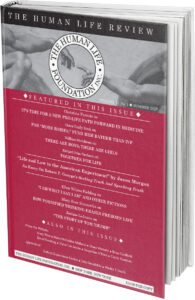Washington Post Tries and Fails to Debunk Study on Mifepristone Dangers
Is the abortion drug mifepristone truly “as safe as Tylenol”? A new report from the Ethics and Public Policy Center is disputing the claim.
Data from the report reveals the real world failure rate of mifepristone is at least 5.26% — double the rate from U.S. clinical trials. They also show 10.93% of women experience a serious adverse event after taking the pill — 22 times the rate of the “less than .05%” on the drug label. These numbers are mere statistics until one realizes that they represent a whopping 94,605 adverse events women experienced associated with mifepristone from 2017 to 2023.
The study found that about one in seven women experience at least one serious adverse event or repeated abortion attempt within 45 days of taking the mifepristone drug. It’s worth noting that the adverse events include sepsis, infection, hemorrhaging, or other serious side effects related to the pill.
Mainstream media outlets that champion chemical abortion were quick to claim that the EPPC study was faulty and unnecessary. The Washington Post, for example, lambasted the study, strongly implying that the study’s alleged lack of peer review, failure to disclose the database used, and alleged inclusion of conditions that were not serious, among other complaints, rendered it hopelessly flawed.
A closer look at the paper’s critiques proves them to be partisan quibbles, rather than serious concerns, while ironically mostly affirming the substance of the report.
The Washington Post’s outrage over the lack of peer-review is interesting considering that policymakers often rely on think tank reports, reporting, and other non-peer-reviewed studies or news to inform their decision-making. The paper also took issue with the fact that the EPPC study did not disclose the database it used for the insurance data in the study – despite the fact that EPPC spokesman Hunter Estes said this information was unavailable due to confidentiality agreements with the vendor.
“Given the high level of politicization and public scrutiny surrounding this topic, there are concerns … about potential backlash or reputational harm to entities associated with this research,” Estes told the Washington Post, adding that anyone could replicate the EPPC’s work: “We do not view the confidentiality of our specific dataset as a barrier for others interested in obtaining similar data and replicating or extending this research.”
The paper downplays the study’s finding that 5.68% of women experienced “other abortion-specific complications” because these were “vague.” However, Estes told the Post that these included complications that sound not only specific, but more serious than the paper seems to want to admit: damage to women’s internal organs from the abortion, fetal tissue left inside the woman’s uterus, kidney failure, and life-threatening mental health diagnoses.
The Washington Post additionally took issue with the inclusion of the EPPC’s statistic of 4.73% of women who had emergency room visits following their chemical abortion – not because it was inaccurate, but because clinical studies in the United States already found that as many as 4.6% of patients had an emergency room visit. You’d think that seeing real-life confirmation of clinical studies ought to be a sober reminder of the risks associated with the drug, but the paper instead saw it as an opportunity to downplay the significance of mifepristone-related ER visits.
The EPPC study additionally found that 3.31% of the total serious adverse events associated with mifepristone involved hemorrhaging. The Post notes the significance of this statistic, which is 33.1 times larger than the previously reported statistic of 0.1%. Predictably, however, the paper downplays this stat by arguing that “normal bleeding occurs with a medication abortion.” There are many women who have experienced a chemical abortion, or used mifepristone in the case of a miscarriage, who can attest that it was one of the most painful experiences of their lives and involved significant bleeding that cannot be minimized as merely “normal.”
The Washington Post was additionally concerned by the fact that the EPPC study included repeated (surgical) abortions as part of the total serious adverse events. The EPPC study found that surgical abortion accounted for 2.84% of total serious adverse events associated with mifepristone. The drug’s label does warn that there is the possibility that the abortion pill will fail in 2.6 to 3.8% of cases, which the paper cites as evidence that the inclusion of this statistic was unnecessary. However, it’s important that the study highlights the rate of surgical follow-ups, which certainly constitute treatment failures and serious adverse events, even if clinical studies already warn that they could happen.
Among other critiques, the Post also claims that mifepristone isn’t supposed to be used with ectopic pregnancies. Ironically, however, this assertion ignores the reality that due to the rollback of commonsense protections on mifepristone, in many cases women are able to acquire abortion drugs online without an in-person consultation, which experts warn is urgently necessary for screening for ectopic pregnancies.
Given the very real possibility that women could acquire mifepristone before confirming an ectopic pregnancy, it’s odd that the paper would take issue with the inclusion of the 0.35% of serious adverse events associated with ectopic pregnancies. If anything, this statistic reflects issues with the reckless dispensation of mifepristone rather than the merits of the report.
At the end of the day, the EPPC report findings suggest very real, concerning rates of serious adverse events associated with mifepristone that Americans and policymakers should not take lightly. Those truly concerned with protecting women ought to reflect on the report’s findings, rather than nitpicking them without actually debunking what they say.










Pingback: The Human Life Review Netflix Show ‘Ginny & Georgia’ Depicts Abortion As Just Another Choice - The Human Life Review